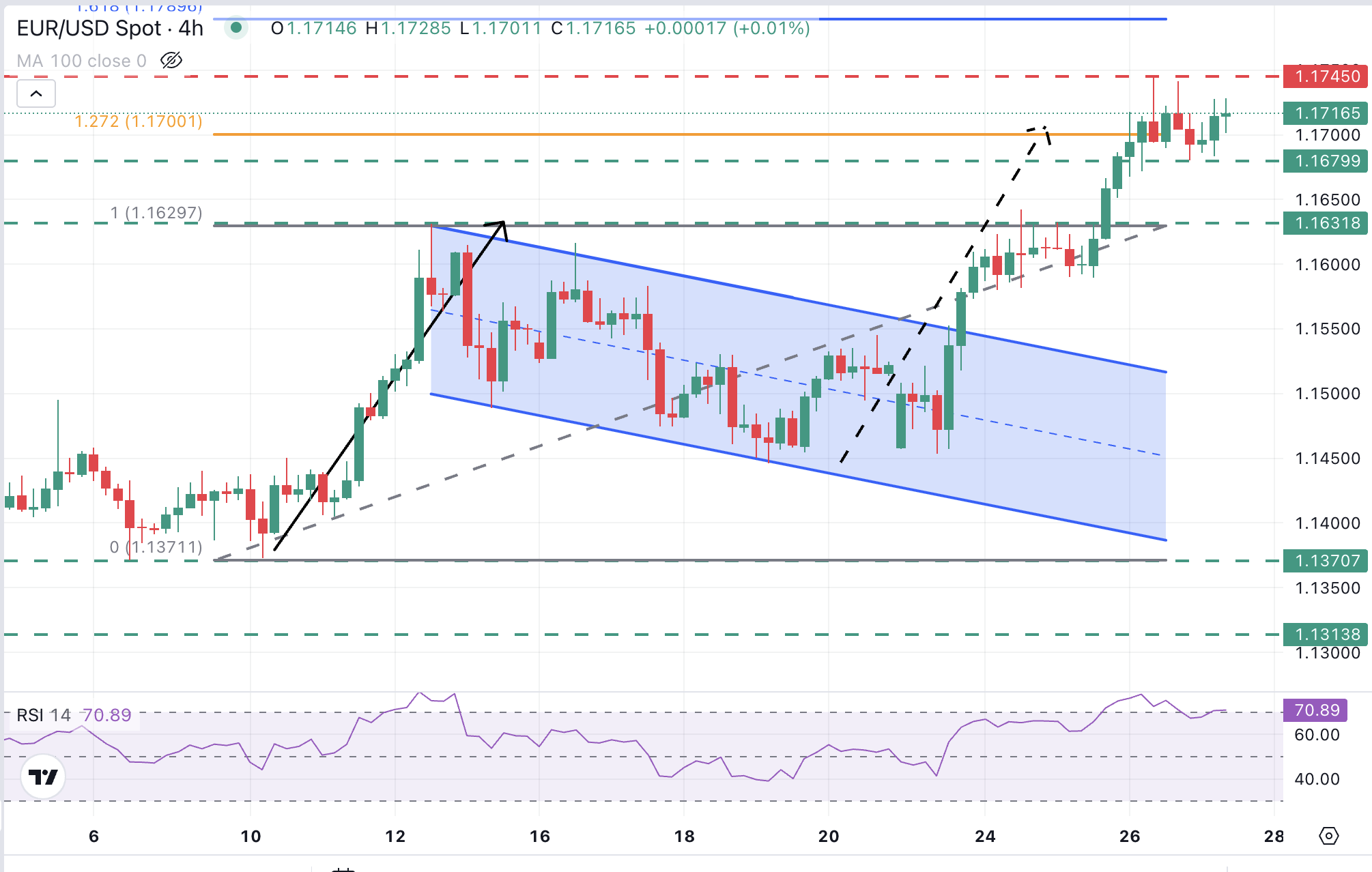
- The Euro consolidates gains with the US Dollar on the defensive.
- Weak US data and Trump’s attacks on Powell have heightened hopes of further Fed interest rate cuts.
- EUR/USD is wavering around 1.1700 with investors looking from the sidelines ahead of US inflation figures.
The EUR/USD pair appreciates for the seventh consecutive day but remains capped below the nearly four-year high at 1.1745 reached on Thursday. The pair is on track for a 2% weekly rally, buoyed by easing geopolitical fears and increasing confidence that the US Federal Reserve (Fed) will cut interest rates two or even three times in the second half of the year.
chair
US President Donald Trump’s attacks on the Fed chair, Jerome Powell, and his comments suggesting an early pick of an allegedly more dovish successor, coupled with weak US economic data and voices within the central bank calling for a less restrictive policy, have boosted hopes of easing interest rates.
Data released this week adds to evidence of a US economic slowdown and points in that direction. On Thursday, the first quarter’s US Gross
Domestic Product (GDP) was revised lower, to a 0.5% contraction from the 0.2% previously estimated, while on Tuesday, the US Conference Board figures revealed a decline in Consumer Confidence, to economic growth.
In the Eurozone, markets remain driven by an optimistic wave as the fragile truce between Israel and Iran holds and keeps Oil prices at relatively low levels. Beyond that, investors remain hopeful that a higher infrastructure and defence plan, which is expected to be approved after the summer, will boost economic activity in the region.
The main focus today is the US Personal Consumption Expenditures (PCE) Price Index, which will be observed for further clues about the Fed’s rate cut calendar. Another moderate inflation reading would cement hopes of a rate cut, probably in September, and might add selling pressure on the US Dollar (USD).
Euro PRICE Today
The table below shows the percentage change of Euro (EUR) against listed major currencies today. Euro was the strongest against the Australian Dollar.
| USD | EUR | GBP | JPY | CAD | AUD | NZD | CHF | |
|---|---|---|---|---|---|---|---|---|
| USD | -0.18% | -0.01% | 0.09% | 0.11% | 0.20% | 0.03% | -0.26% | |
| EUR | 0.18% | 0.12% | 0.24% | 0.26% | 0.35% | 0.07% | -0.15% | |
| GBP | 0.00% | -0.12% | 0.14% | 0.11% | 0.22% | -0.01% | -0.17% | |
| JPY | -0.09% | -0.24% | -0.14% | 0.01% | 0.10% | -0.23% | -0.28% | |
| CAD | -0.11% | -0.26% | -0.11% | -0.01% | 0.13% | -0.20% | -0.33% | |
| AUD | -0.20% | -0.35% | -0.22% | -0.10% | -0.13% | -0.28% | -0.41% | |
| NZD | -0.03% | -0.07% | 0.00% | 0.23% | 0.20% | 0.28% | -0.13% | |
| CHF | 0.26% | 0.15% | 0.17% | 0.28% | 0.33% | 0.41% | 0.13% |
The heat map shows percentage changes of major currencies against each other. The base currency is picked from the left column, while the quote currency is picked from the top row. For example, if you pick the Euro from the left column and move along the horizontal line to the US Dollar, the percentage change displayed in the box will represent EUR (base)/USD (quote).
Daily digest market movers: Weak data and Trump’s pressure on the Fed are hammering the USD
- The US Dollar depreciated across the board this week. The US Dollar Index (DXY), which measures the value of the Greenback against six major currencies, has lost about 1.7% in the last five days and more than 11% in 2025 so far, hit by a mix of a weakening economy, investors’ concerns about Trump’s erratic trade policy and, ultimately, his attacks to the Federal Reserve’s Independence.
- Trump attacked the Fed chair, calling him “terrible” and “an average mentally person” after Powell reiterated the bank’s cautious stance towards interest rates, and weighed in on announcing his successor after the summer, more than six months before the end of his term. These comments have boosted hopes of Fed rate cuts, and, more importantly, have put the central bank’s independence into question, eroding the US Dollar’s reserve currency status.
- In the macroeconomic data domain, the Eurozone’s Economic Sentiment Indicator has deteriorated to 94.0 against expectations of a slight improvement to 95.12 from May’s 94.8. Consumer Confidence has remained steady at -15.3, and the Business Climate Index has dropped to -078 from -057 in the previous month. The services sentiment has been the only positive news, with an improvement to 2.9 against expectations of a decline to 1.6 after May’s 1.8 reading.
- France’s Preliminary CPI data has shown a larger-than-expected increase in inflation while consumer spending slowed down, although less than expected. Likewise, Spain’s Consumer inflation accelerated in June and Retail Sales increased in May.
- On Thursday, the US GDP Annualized was revised down to a 0.5% contraction in the first three months of the year, amid a decline in consumption, following Trump’s increase in tariffs for imported goods.
- On the other hand, US Durable Goods Orders increased beyond expectations in May, with a sharp increase in orders for aircraft. The headline reading humped 16.4%, about twice the 8.5% increase expected by the market, while excluding transportation orders grew 0.5% against expectations of a flat reading.
- Weekly Jobless Claims data was mixed, with initial claims for unemployment benefits increasing less than expected, but with continuing claims steady at their highest levels since the post-pandemic period, which strengthens the case for a weakening and adds pressure on the Federal Reserve to cut interest rates further.
- Today all eyes will be on the US PCE Prices Index release, the Federal Reserve’s inflation gauge of choice, which is expected to show no further evidence of the impact of tariffs on consumer prices. The headline inflation is expected to have grown at a steady 0.1% pace in May, with year-on-year growth accelerating to 2.3% from 2.1% in the previous month. The core Index is also seen unchanged at 0.1% in the month and 2.6% Y-o-Y, up from 2.5% in April.
EUR/USD is struggling to consolidate above 1.1700

EUR/USD maintains its bullish trend intact on Friday, favoured by US Dollar weakness. The pair, however, has reached the target of the previous two weeks’ bullish flag formation, right above 1.1700, and needs further reasons to climb higher. Today, all eyes are on the US PCE Prices Index, which is likely to determine the pair’s near-term direction. Until that moment, further sideways trading is expected.
On the downside, the pair is finding support at the 1.1680 intraday low ahead of the previous resistance, now a potential support area at 1.1630-1.1640 (June 12, 24, and 25 highs).
Immediate resistance is at Thursday’s high of 1.1745 and above here, the 161.8% Fibonacci extension of the June 10-12 rally at 1.1795.
Economic Indicator
Personal Consumption Expenditures – Price Index (MoM)
The Personal Consumption Expenditures (PCE), released by the US Bureau of Economic Analysis on a monthly basis, measures the changes in the prices of goods and services purchased by consumers in the United States (US).. The MoM figure compares prices in the reference month to the previous month. Price changes may cause consumers to switch from buying one good to another and the PCE Deflator can account for such substitutions. This makes it the preferred measure of inflation for the Federal Reserve. Generally speaking, a high reading is bullish for the US Dollar (USD), while a low reading is bearish.
Economic Indicator
Core Personal Consumption Expenditures – Price Index (MoM)
The Core Personal Consumption Expenditures (PCE), released by the US Bureau of Economic Analysis on a monthly basis, measures the changes in the prices of goods and services purchased by consumers in the United States (US). The PCE Price Index is also the Federal Reserve’s (Fed) preferred gauge of inflation. The MoM figure compares the prices of goods in the reference month to the previous month.The core reading excludes the so-called more volatile food and energy components to give a more accurate measurement of price pressures. Generally, a high reading is bullish for the US Dollar (USD), while a low reading is bearish.
After publishing the GDP report, the US Bureau of Economic Analysis releases the Personal Consumption Expenditures (PCE) Price Index data alongside the monthly changes in Personal Spending and Personal Income. FOMC policymakers use the annual Core PCE Price Index, which excludes volatile food and energy prices, as their primary gauge of inflation. A stronger-than-expected reading could help the USD outperform its rivals as it would hint at a possible hawkish shift in the Fed’s forward guidance and vice versa.
Information on these pages contains forward-looking statements that involve risks and uncertainties. Markets and instruments profiled on this page are for informational purposes only and should not in any way come across as a recommendation to buy or sell in these assets. You should do your own thorough research before making any investment decisions. FXStreet does not in any way guarantee that this information is free from mistakes, errors, or material misstatements. It also does not guarantee that this information is of a timely nature. Investing in Open Markets involves a great deal of risk, including the loss of all or a portion of your investment, as well as emotional distress. All risks, losses and costs associated with investing, including total loss of principal, are your responsibility. The views and opinions expressed in this article are those of the authors and do not necessarily reflect the official policy or position of FXStreet nor its advertisers. The author will not be held responsible for information that is found at the end of links posted on this page.
If not otherwise explicitly mentioned in the body of the article, at the time of writing, the author has no position in any stock mentioned in this article and no business relationship with any company mentioned. The author has not received compensation for writing this article, other than from FXStreet.
FXStreet and the author do not provide personalized recommendations. The author makes no representations as to the accuracy, completeness, or suitability of this information. FXStreet and the author will not be liable for any errors, omissions or any losses, injuries or damages arising from this information and its display or use. Errors and omissions excepted.
The author and FXStreet are not registered investment advisors and nothing in this article is intended to be investment advice.
Editors’ Picks

EUR/USD consolidates gains near 1.1700 ahead of US data
EUR/USD is consolidating its latest upside near 1.1700 in European trading on Thursday. The US Dollar remains weak across the board as investors stay wary about the future of the Fed’s independence in Trump’s 2.0 era. The focus now shifts toward ECB-speak and mid-tier US data for fresh impetus.

GBP/USD stays firm above 1.3700, near fresh multi-year highs
GBP/USD holds its winning streak for the fourth successive session, trading above 1.3700 in the European session on Thursday. The pair hangs close to three-year highs amid sustained US Dollar weakness, in light of US President Trump’s fresh attack on the Fed’s credibility. US data and BoE-speak awaited.

Gold price retains its positive bias amid a broadly weaker USD; lacks bullish conviction
Gold price trades with a mild positive for the second straight day on Thursday, though it lacks follow-through and remains below the $3,350 level through the early European session. Reports that US President Donald Trump was considering replacing Federal Reserve Chair Jerome Powell raised concerns over the future independence of the US central bank.

Could Iran block the Strait of Hormuz? Why Oil is on edge after US strikes
As the Israel-Iran conflict reaches new heights, an old threat is coming back to haunt the markets: that of the closure of the Strait of Hormuz. This narrow arm of the sea in the Persian Gulf, wedged between Iran to the north and the United Arab Emirates and Oman to the south, is much more than a simple sea passage.

The Best brokers to trade EUR/USD
SPONSORED Discover the top brokers for trading EUR/USD in 2025. Our list features brokers with competitive spreads, fast execution, and powerful platforms. Whether you’re a beginner or an expert, find the right partner to navigate the dynamic Forex market.








